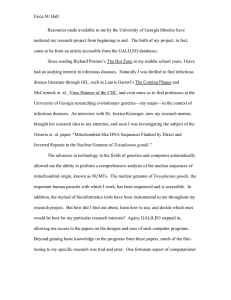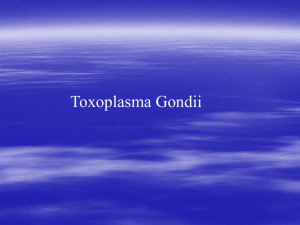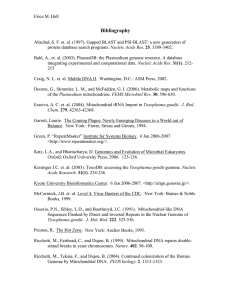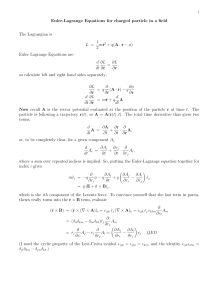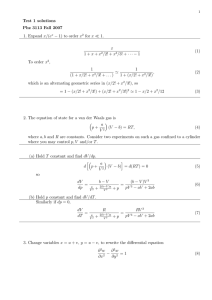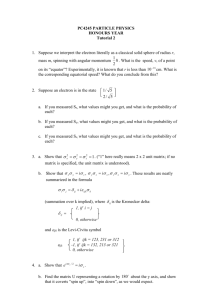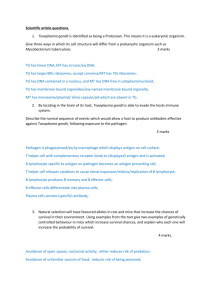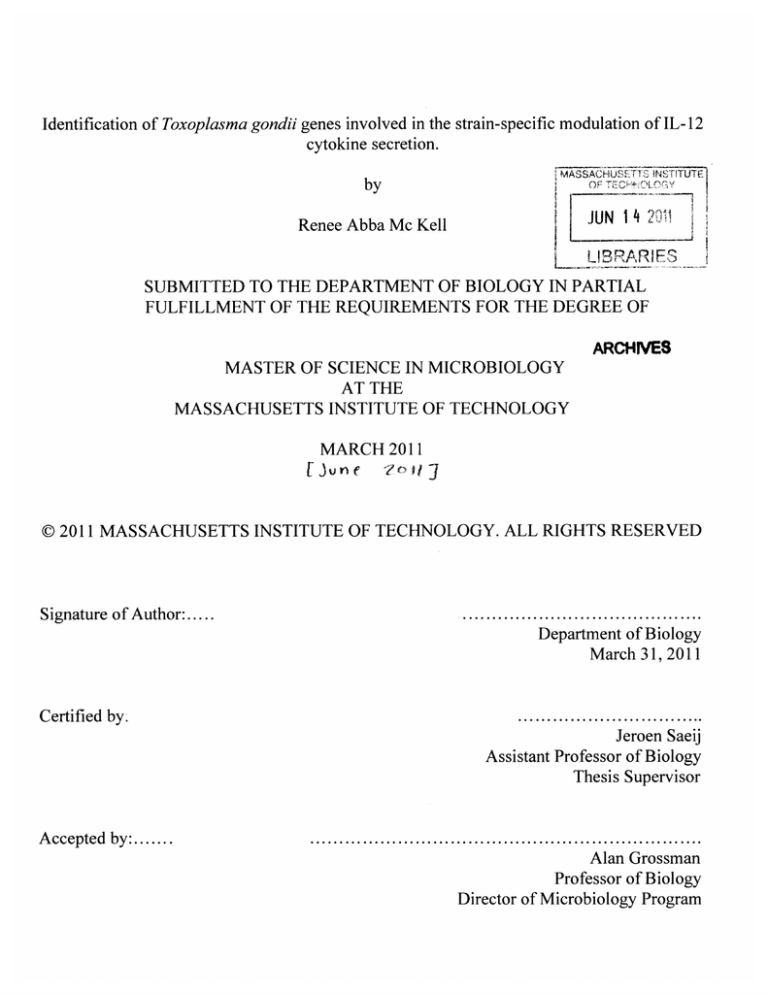
Identification of Toxoplasma gondii genes involved in the strain-specific modulation of IL-12
cytokine secretion.
by
fT UTEMASSACHUSI:TTS IN1,0
JUN 14
Renee Abba Mc Kell
L'BRARIFS
SUBMITTED TO THE DEPARTMENT OF BIOLOGY IN PARTIAL
FULFILLMENT OF THE REQUIREMENTS FOR THE DEGREE OF
ARCHNES
MASTER OF SCIENCE IN MICROBIOLOGY
AT THE
MASSACHUSETTS INSTITUTE OF TECHNOLOGY
MARCH 2011
© 2011 MASSACHUSETTS INSTITUTE OF TECHNOLOGY. ALL RIGHTS RESERVED
Signature of Author:.....
Department of Biology
March 31, 2011
Certified by.
Jeroen Saeij
Assistant Professor of Biology
Thesis Supervisor
Accepted by:.......
Alan Grossman
Professor of Biology
Director of Microbiology Program
Identification of Toxoplasma gondii genes involved in the strain-specific modulation of IL-12
cytokine secretion.
by
Renee Abba Mc Kell
Submitted to the Department of Biology
on March 31, 2011 in Partial Fulfillment of the
Requirements for the Degree of Master of Science in Microbiology
ABSTRACT
Toxoplasma gondii is an intracellular pathogen that causes life-threatening toxoplasmosis in
developing fetuses and immune-compromised individuals. An immune response to a Toxoplasma infection is
characterized by the stimulation of high levels of interleukin- 12 (IL- 12), followed by the production of
interferon-y (IFN-y) by immune cells. Although IFN-y is the main mediator of resistance to Toxoplasma
infection, Toxoplasma is able to manipulate the immune response through the regulation of IL- 12 production.
Toxoplasma has been shown to modulate the induction of IL-12 in a strain-specific manner. An
infection with a type II strain, but not type I and III strains, induce high levels of IL- 12 production by
macrophages in vitro. Previous studies have implicated two Toxoplasma genes that play a role in this strainspecific difference in IL- 12 production. A rhoptry protein kinase, ROP 16, from type I and III strains, was
found to be crucial in the suppression of IL-12. A type II dense granule protein, GRA 15, induces IL-12
through NF-KB activation.
I have screened F1 progeny from a type III x type II cross for IL-12 induction and NF-KB activation.
My preliminary experiments indicate that there are other Toxoplasma factors involved in the strain-specific
inhibition of IL-12, and this inhibition has a genetic basis. To understand the role of IL-12 regulation by
Toxoplasma, I intend to (i) identify novel Toxoplasma genes involved in the inhibition of IL- 12 secretion (ii)
test and characterize the effects of the Toxoplasma protein ROP38 on IL-12 signaling and (iii) determine the
target/s of Toxoplasma inhibition of IL-12 production.
Thesis Supervisor: Jeroen Saeij
Title: Assistant Professor of Biology
Background and Significance
Toxoplasma gondii is an obligate intracellular protozoan parasite capable of infecting most warmblooded animals including humans (reviewed in[1]). The sexual cycle of Toxoplasma occurs exclusively in
felines, with two stages present in intermediate hosts: the rapidly replicating tachyzoites and the dormant
encysted bradyzoites (reviewed in[2]). Intermediate hosts become infected with Toxoplasma by ingesting
oocytes from cat feces or tissue cysts from the flesh of another intermediate host. The majority of
Toxoplasma strains from Europe and North America belong to three distinct clonal lineages, referred to as
types I, II and 111[3]. Generally, immune-competent people infected with these strains do not suffer from any
symptoms, although a life-long chronic infection is established. However, severe and life threatening disease
in immunocompromised individuals and developing fetuses of pregnant women infected for the first time can
develop.
Toxoplasma has three secretory organelles: micronemes, rhoptries and dense granules
(reviewed in[4,5]). Active invasion of Toxoplasma into the host cell involves the sequential release of
proteins from these organelles along with the formation of a parasitophorous vacoule (PVM) around the
parasite (reviewed in[6]). Proteins released from the rhoptries and dense granules can traffic to the locations
in the host cell, including the host nucleus and outside of the PVM where they are able to modulate hostsignaling pathways.
A primary infection with a pathogen stimulates high levels of the proinflammatory cytokine
interleukin- 12 (IL- 12) by phagocytic cells of the innate immune system. IL- 12 then stimulates T cells and
natural killer (NK) cells to produce the cytokine IFN-y, which stimulates cells to induce anti-pathogen gene
expression programs (reviewed in[7]). IL-12 is required for resistance to toxoplasmosis due to its essential
role in stimulating the production of IFN- y [8,9]. The biologically active form of IL-12 is comprised of two
disulfide-linked subunits, p40 and p35 (reviewed in[7]). In-vivo studies have demonstrated the importance of
both subunits in the resistance to Toxoplasma infection. Both IL-12p40-/- and IL-12p35-/- mice are highly
susceptible to toxoplasmosis, and neutralization of IL- 12 in Toxoplasma infected mice results in reduced
IFN-y production, uncontrollable parasite load and increased susceptibility[ 10].
Toxoplasma has been shown to modulate the induction of IL- 12 in a strain-specific manner. An
infection with a type II strain, but not type I and III strains, induces high levels of IL- 12 production by
macrophages in vitro[1 1]. Initiation of signaling pathways that affect IL-12 production is one way this strainspecific difference arises. Previous studies have shown that interference with nuclear factor-KB (NF-KB)
translocation, activation of signal transducer and activator or transcription 3 and 6(STAT3/6) and mitogenactivated protein kinases (MAPK) activation leads to the strain differences in IL- 12 induction.
The p40 promoter contains KB -binding sites and is transcriptionally regulated by NF-KB[12].
Infection of macrophages with type II strains, but not type I or III strains, induces the activation of NF-KB
resulting in the induction of IL- 12 production [11-13]. GRA 15, a Toxoplasma dense granule protein, from
type II strains activates NF-KB resulting in the induction of IL-12p40[14][table 1].
STAT proteins are transcription factors, which mediate the effects of many cytokines. Activated
STAT3 and STAT6 negatively regulate IL-12 proinflammatory responses, thus preventing detrimental
systemic inflammation as a result of uncontrolled proinflammatory cytokine production (reviewed in[15]).
Activation of STAT3 inhibits p40 gene expression by preventing NF-KB recruitment to its promoter[16].
Overexpression of STAT6 inhibits NF-KB nuclear translocation[17]. Toxoplasma has been shown to hijack
these regulatory systems to suppress IL- 12 production. A rhoptry protein kinase, ROP 16, from types I and III
strains, induces prolonged STAT3/6 phosphorylation leading to low levels of IL- 12 production[ 18] [table 1].
MAPK transduction cascades culminate in the induction of multiple proinflammatory genes that are
important in the defense against pathogens, including
IL-12p40[19-2 1]. MAPK signaling is initiated through toll-like receptor (TLR) engagement of a pathogen
associated molecular patterns (PAMPs) resulting in the recruitment of the adapter molecule myeloid
differentiation factor 88(MyD88)(reviewed in [22]). This leads to the sequential association of intracellular
protein molecules that activate MAPKs. Present in both cytosolic and nuclear compartments, activated
MAPKs include extracellular signal- regulated kinase (ERK), p38 MAPK, and stress-activated protein
kinase/c-Jun N-terminal kinase(SAPK/JNK)(reviewed in[22]).Upon activation, they themselves activate
numerous transcription factors including CCAAT-enhancer-binding protein p(C/EBPs),which bind to the
IL-12p40 promoter[23]. In response to soluble Toxoplasma antigen (STAg), macrophages activate the
TRAF6-dependent phosphorylation of MAPK family members p38 and ERK1/2[24]. Using specific
inhibitors of MAPK phosphorylation, Toxoplasma-induced phosphorylation of p38 promoted IL- 12
production, while phosphorylation of ERKl/2 inhibited IL-12 [25]. Intestinal epithelial cells infected with
strains from all three lineages, differed in their ability to induce phosphorylation of ERK1/2[26], but the
genetic basis behind this difference is unknown.
Current data generated in the Saeij lab suggests that there are other Toxoplasma proteins involved in
the strain-specific induction of IL-12.Expression of type I ROP16 (ROP 161) in a type II strain (II: ROP 161)
decreases the levels of IL-12. Expression of GRA15 11 in a type I strain (I: GRA15 11) increases the levels of
IL-12 secreted. However, a type I ROP16 knockout (I:ROP16KO) expressing GRA15 11(I:ROP16KO+
GRA15 11) still induces lower levels of IL-12 than infection with a type II strain [fig 1].
The goal of my thesis was to understand the role of IL- 12 regulation by Toxoplasma through the
following aims:
i.
Identify novel Toxoplasma genes involved in the inhibition of IL- 12 secretion.
ii.
Test and characterize the effects of the Toxoplasma protein ROP38 on IL-12 signaling.
iii.
Determine the target/s of Toxoplasma inhibition of IL-12 production.
RESULTS
Genetic analysis indicates more than two Toxoplasma genes regulate macrophage IL-12 secretion.
To further explore this possibility, I first screened F1 progeny from a type II x type III cross for IL- 12
induction and NF-KB activation. Because Toxoplasma tachyzoites are haploid all alleles are expressed in the
phenotype of interest because there is no masking of recessives by dominant alleles. Therefore, the F 1
generation can be used to screen for genes without further crosses. These progeny contain the type II copy of
both GRA 15 and ROP 16 (fig.2), thus eliminating the possibility that any detected difference between the
progeny is due to these genes. These F 1 progeny exhibited varied levels of IL-12 secretion and NF-KB
activation [fig. 3]. This is consistent with our proposed hypothesis that, in addition to GRA15 and ROP 16,
there are other Toxoplasma molecules involved in the modulation of IL-12.
Coinfection indicates another Toxoplasma gene inhibits IL-12 induction.
Interestingly, a coinfection with F 1 progeny strains that induce low levels of IL- 12 and the F 1
progeny that induces the highest level of IL-12, suggests that there may be an inhibitory type III Toxoplasma
protein responsible for low levels of IL-12 production [fig. 4]. This inhibitory Toxoplasma factor responsible
for low levels of IL- 12 production is present in one or more of these progeny strains.
Future Directions
The experiments proposed below aim to determine the type III Toxoplasma gene(s) responsible for
the inhibition of IL- 12 induction. The genes discovered could then be further characterized to determine the
molecular mechanisms governing their function. These experiments will further the understanding of how
Toxoplasma is able to manipulate the host immune response through the selective regulation of IL-12, and
may present new targets for treatment of Toxoplasma.
Experimental Design
Aim 1: Identify novel Toxoplasma genes involved in the inhibition of IL-12 secretion.
The overall goal of this aim is to determine new Toxoplasma factors that are responsible for inhibition
of IL- 12 induction. While enzyme linked-immunosorbent assay (ELISA) is most commonly used to detect
cytokine levels, a reporter cell line would allow for quantification of IL- 12 promoter activity. Also, one
would gain some understanding of how IL- 12 gene expression is regulated by Toxoplasma through the
specific and rapid analysis of its promoter activity. Therefore, a stable reporter cell line will be developed in
RAW264.7 murine macrophages. Lentivirus will be used to deliver constructs containing the p35 and p40
promoter sequences driving the expression of reporter proteins, GFP and Firefly Luciferase. This will allow
for the direct quantification of IL- 12 mediated transcription in populations of Toxoplasma-infected cells.
Sub-aim 1.1: Identify genes necessary for IL-12 inhibition by mutagenesis
Toxoplasma has a high frequency of non-homologous end joining, thus allowing random insertional
mutagenesis by transfection of a plasmid. Because of the haploid nature of Toxoplasma tachyzoites,
insertional mutagenesis can lead to both loss of function and gain of function mutations without the
requirement of further crosses.
Fl progeny (with type II copies of both ROP16 and GRA15) will be selected for mutagenesis based on two
criteria. They should induce relatively low levels of IL-12 compared to the wild-type type II strain and be
able to inhibit the IL- 12 induction ability of the type II strain. After transfection of a plasmid, parasites
containing insertions will be selected for and IL-12 reporter cell lines will be infected with pools of these
mutants. Several rounds of flow cytometry (FACS) analysis will be done to obtain individual mutant
parasites that induce higher levels of IL- 12 than the unmutated F 1 strain. Once mutants are found that do
activate the reporter cell line, ELISA will be done to confirm this result. To identify the gene disrupted by
plasmid insertion, plasmid rescue or inverse PCR will be done followed by sequencing.
An alternative approach would be to complement the Fl progeny strain that induces the highest level
of IL- 12 with a type III cosmid library. Cosmid clones capable of complementing the mutant phenotype will
be determined by plasmid rescue or inverse PCR. Because many loci are covered by a single cosmid, the
candidate loci of interest will be narrowed and confirmed using overlapping cosmids. Once type III genes are
found, they will be cloned and knocked out or overexpressed in type II strains to confirm their inhibitory
phenotype.
Sub-aim 1.2: Candidate gene approach
Given the F1 progeny data that I have generated [fig.2], an alternative approach would be to
determine the genomic location common to all F 1 progeny from the type II x type III cross that are able to
inhibit IL-12. To achieve this, I will perform a coinfection experiment using all the F] progeny with the type
II copy of ROP16 and the F1 progeny strain that induces the highest level of IL-12. Importantly, the 40 Fl
progeny from the type II x type III cross have been genotyped at 135 informative markers across the genome.
This allows for the identification of candidate genes that are tightly linked to these genetic markers. The
genomic locations common to all F1 strains that inhibit IL-12 will be examined and potential candidate genes
will be chosen using a set of criteria. It is expected that candidate proteins will be secreted into the host cell
and thus have a signal peptide. Candidate genes should also be polymorphic or differentially expressed
between type II and III strains. Candidate type III genes that fit the above criteria and are present within the
common genomic region will be cloned and expressed transgenically in type II strains and tested for IL- 12
inhibition. Candidate gene knockouts or overexpression in the Toxoplasma strain from which it came from
will be used verify its role in this phenotype.
Aim 2: Test and characterize the effects of the Toxoplasma protein ROP38 on IL-12 signaling.
A recently described rhoptry protein, ROP38, has been implicated in the modulation of host genes
associated with ERK1/2 signaling[27]. Expression levels of ROP38 vary among strains and it is secreted into
the host cell therefore presenting itself as a candidate gene for inhibition of IL-12 induction. Overexpression
of ROP38 will be done to first determine if it is responsible for pERKl/2 levels in Toxoplasma infected cells.
To investigate if ROP3 8 inhibits IL- 12 secretion in a p-ERK1 /2 dependent manner, the protein will be cloned
and tagged from the strain in which it activates p-ERK1/2 and expressed transgenically in a strain that
activates IL-12. I will use these transgenic parasites to infect bone-marrow derived macrophages (BMDMs)
and ELISA will be performed to measure both IL-12p40 and IL-12p70 levels. Overexpression of ROP38
should replicate pERKl/2 inhibition of IL-12. To further characterize the role of ROP38 in IL-12 inhibition,
microarrays will be done to assess the effect of ROP38 on global gene expression in infected BMDMs.
Aim 3: Determine the target of Toxoplasma inhibition in IL-12 induction.
The p40 and p35 genes are regulated at the level of transcription by a number of transcription factors
(reviewed in[7]). In addition to NF-KB and C/EBP, the p40 gene is positively regulated by an ETS site
upstream of the NF-KB binding sequence, which is made up of a large complex composed of ETS-2, PU. 1,
interferon regulatory factor-I (IRF-1) and the NF-KB subunit, c-Rel [28]. Interferon consensus sequence
binding protein (ICSBP) also interacts with the ETS-site[29] and ICSBP-/- mice are susceptible to
Toxoplasma infection, which is associated with decreased IL-12p40 production[30]. ICSBP and IRF-1 also
regulate human p35 transcription by binding to the ICSBP-response element in-vivo[3 1]. Inhibition has also
been found to act at the level of transcription, with a repressor site located between the ETS and NF-KB sites.
This site known as GA-12, (GATA sequence in the IL-12 promoter) is occupied by a GA-12-binding protein
(GAP12) in unstimulated cells[32]. Interestingly, a past study showed that hyperactivation of the ERK
pathway led to the activation of GAP- 12, resulting in repression of IL- I2p40 production in LPS-stimulated
mouse macrophages[33].
Transcription of either the p40 or p35 genes could be inhibited by Toxoplasma through the
competition by inhibitory proteins for DNA binding sites and the induction of inhibitory gene products.
Toxoplasma may activate other pathways in the cell, for instance ERKl/2 signaling pathway, which can
inhibit IL- 12 production through any of the mechanisms mentioned above. The Toxoplasma protein
identified from the mutagenesis experiment could play a role in the inhibition ofp40 orp35 transcription.
To test if the candidate Toxoplasma protein competes for DNA binding sites, an electrophoretic
mobility-shift assay will be done. Radiolabeled oligonucleotides encompassing the p40 and p35 promoter
sequences will be incubated with the HA-tagged candidate Toxoplasma protein. The mixture will be resolved
by SDS-PAGE and the presence of the protein will be assessed using anti-HA antibody. It is possible that the
Toxoplasma protein may not bind directly to the promoter, but may induce inhibitory proteins that are
possible binding partners of the selected Toxoplasma protein. To identify possible binding partners,
HA-tagged Toxoplasma protein will be ectopically expressed in the Fl strain from which it came from.
Transgenic parasites will be infected into BMDMs, and cell extracts will be prepared post-infection. The
proteins will be immunoprecipitated using anti-HA antibodies and interacting partners will be identified by
mass spectrometry analysis. Confirmed interaction partners will prove useful in determining the mechanism
of IL-12 inhibition.
Conclusion
The proposed experiments will help elucidate the mechanisms that Toxoplasma gondii uses to evade
the host immune response and establish a chronic infection. Identification and characterization of the
Toxoplasma genes involved in IL- 12 inhibition will be useful in understanding how the pro-inflammatory
response is manipulated by the parasite to ensure its survival and that of the host. The characterization of
IL- 12 inhibition may also present new targets for treatment of Toxoplasma in humans.
Material and Methods
Parasites and cells.
Parasites were maintained in vitro by serial passage on monolayers of HFFs at 37'C in 5% CO 2. Me49 and
CTG were used as representative type II and type III strains respectively. The F 1 progeny from type II x type
III crosses were described previously [34]. BMDM were obtained from C57BL/6 mice and maintained in
RPMI supplemented with 20% L929 cell-conditioned medium, 10% heat-inactivated FBS, 2mM
1-glutamine, 1mM sodium pyruvate, 1x MEM nonessential amino acids, and 50 pg/ml of streptomycin. A
HEK293 stable cell line expressing four copies of the NF-KB consensus transcriptional response element
driving the expression of GFP and luciferase (System Biosciences) were grown in DMEM supplemented
with 10% heat-inactivated FBS, 2mM 1-glutamine, 1-mM sodium pyruvate, 1 x MEM nonesstional amino
acids, 10mM HEPES, 50 pig/ml of streptomycin and 20 ptg/ml gentamycin.
In vitro cytokine ELISA.
C57BL/6 BMDMs were seeded (5 x 104 per well) in 96-well plates and left to adhere overnight at 370 C in
5% CO 2 . Cells were infected with freshly lysed Toxoplasma gondii tachyzoites at MOI =10,5,2.5, and
supernatants (200 pl) were collected 24hrs post-infection and stored at -20'C if necessary. IL-12p40/p70
levels were determined, for the cells infected with equal numbers of viable parasites as determined by plaque
assay, using a commercially available ELISA kit (eBiosciences Mouse IL- 12 (p40), IL- 12 (p70) ELISA Set)
according to the manufacturer's instructions.
Reporter assay
NF-KB/293/GFP-Luc cells were seeded (5 x 104 per well) in 96-well plates and left to adhere 4 hrs before
infection at 370 C in 5% CO 2 . Cells were infected with freshly lysed Toxoplasma gondii tachyzoites at
MOI = 10,5,2.5. After 24hrs post-infection, cells were lysed and assayed with the Dual-Luciferase assay
system (Promega). Firefly luciferase activity was measure in triplicate and normalized to uninfected cells.
Plaque Assay
For all infection assays, cells were infected with different MOIs and a plaque assay was done to determine
the viability of each strain. 100 parasites per well were added to confluent HFFs in a 24-well plate and
incubated for 5-7 d at 37'C. The number of plaques was counted using a microscope and the percent viability
determined.
.....................
......
....
. .....
.
.............
Table 1: Toxoplasma genes that modulate IL-12 production
Type I
ROP16
Type II
Type III
+
+
GRA15
+
IL-12
+
IL-12p40 Secretion
1800
1600
-
* type I
1400
-
O typel:GRA15II
-
* typel:ROPl61KO
+GRA15II
U type II
600
-
U type II:GRA 15KO
400
200
-
O typell:ROP 161
1200
1000
800
0-
-
ill'-
Figure 1: IL-12p4O secretion from Toxoplasma infected BMDMs 24hrs post-infection
Expression of ROP 161 in a type II strain decreases the levels of IL- 12 and expression of GRA 151 in a type I
strain increases the levels of IL-12 secreted. However, a type I ROP16KO expressing GRA1511 still induces
lower levels of IL- 12 than infection with a type II strain, suggesting that other Toxoplasma proteins are
involved in the strain-specific induction of IL- 12
Ste7 S27 S25 type III type IIStelO D3X1
Ste7 S27 S25 D3X1 StelO type III type II
Figure 2: Genotyping of F 1 progeny.
A, HindIII restriction digest pattern of ROP16 fragment amplified from genomic DNA of Toxplasma. The
restriction digest of the F1 progeny resulted in two fragments 1585bp and 539bp. This corresponds to type II
ROP16. B, PCR amplified GRA15 fragment from genomic DNA of Toxoplasma. The Fl progeny posses the
type II GRA15(~1.7kb).
IL-12p70 Secretion
2500
2000
1500
1000
500
type III
type II
S25
S27
Ste7
StelO
D3x1 Uninfected
StelO
D3X1 uninfected
IL-12p40 Secretion
10000
8000
6000
4000
2000
0
type III
type II
S25
S27
Ste7
NF-KappaB activation
120
100
Type II Type III
S25
S27
II I
Ste7
STe1O
D3X1
Figure 3: IL-12p40, IL-12p70 and NF-KappaB induction24 hrs post infection.
F 1 progeny from a type II x type III cross exhibit varied levels of IL- 12
secretion and NF-KappaB induction. These progeny contain the type II copy of both GRA 15 and
ROP 16, thus eliminating the possibility that any detected difference between the progeny
is due to these genes.
IL-12p40 production
350
-
300
-
250
-
200
-
150
-
100
-
I
'I
50
0-
&
2000
IL-12p70 production
1500
1000
500
0
4'..
Figure 4: IL-12p40 and IL-12p70 secretion 24hrs post-infection.
A coinfection with FI progeny strains that induce low levels of IL-12 (Ste 10 and D3X1) and the F1 progeny
that induces the highest level of IL-12 (S27), suggests that there may be an inhibitory type III Toxoplasma
protein responsible for low levels of IL- 12 production. The bracketed numbers represent the respective
MOIs.
References:
1. Dubey, J.P. (2007). The history and life cycle of toxoplasma gondii. In: Weiss, L., Kim, K.,
editors.Toxoplasma gondii. The Model Apicomplexan: Perspectives and Methods. San Diego,
CA:Academic Press. p. 1-17.
2. J.P. Dubey, "Advances in the life cycle of Toxoplasma gondii.," InternationalJournalfor
Parasitology,vol. 28, 1998, pp. 1019-1024.
3. D.K. Howe and L.D. Sibley, "Toxoplasma gondii comprises three clonal lineages: correlation of
parasite genotype with human disease.," The Journal ofInfectious Diseases,vol. 172, 1995, pp. 156 11566.
4. J.C. Boothroyd and J.-F. Dubremetz, "Kiss and spit: the dual roles of Toxoplasma rhoptries.," Nature
Reviews Microbiology, vol. 6, 2008, pp. 79-88.
5. V.B. Carruthers, "Armed and dangerous: Toxoplasma gondii uses an arsenal of secretory proteins to
infect host cells.," Parasitologyinternational,vol. 48, Mar. 1999, pp. 1-10.
6. M.W. Black and J.C. Boothroyd, "Lytic cycle of Toxoplasma gondii.," Microbiology and molecular
biology reviews MMBR, vol. 64, 2000, pp. 607-623.
7. G. Trinchieri, "Interleukin-12 and the regulation of innate resistance and adaptive immunity.," Nature
Reviews Immunology, vol. 3, 2003, pp. 133-146.
8. R.T. Gazzinelli, M. Wysocka, S. Hayashi, E.Y. Denkers, S. Hieny, P. Caspar, G. Trinchieri, and A.
Sher, "Parasite-induced IL- 12 stimulates early IFN-gamma synthesis and resistance during acute
infection with Toxoplasma gondii.," The JournalofImmunology, vol. 153, 1994, pp. 2533-2543.
9. T.M. Scharton-Kersten, T.A. Wynn, E.Y. Denkers, S. Bala, E. Grunvald, S. Hieny, R.T. Gazzinelli,
and A. Sher, "In the absence of endogenous IFN-gamma, mice develop unimpaired IL- 12 responses
to Toxoplasma gondii while failing to control acute infection.," The JournalofImmunology, vol. 157,
1996, pp. 4045-4054.
10. L.A. Lieberman, F. Cardillo, A.M. Owyang, D.M. Rennick, D.J. Cua, R.A. Kastelein, and C.A.
Hunter, "IL-23 provides a limited mechanism of resistance to acute toxoplasmosis in the absence of
IL-12.," The Journal ofImmunology, vol. 173, 2004, pp. 1887-1893.
11. P.M. Robben, D.G. Mordue, S.M. Truscott, K. Takeda, S. Akira, and L.D. Sibley, "Production of IL12 by macrophages infected with Toxoplasma gondii depends on the parasite genotype.," The Journal
ofImmunology, vol. 172, 2004, pp. 3686-3694.
12. T.L. Murphy, M.G. Cleveland, P. Kulesza, J. Magram, and K.M. Murphy, "Regulation of interleukin
12 p40 expression through an NF-kappa B half-site.," Molecular and cellularbiology, vol. 15, Oct.
1995, pp. 5258-67.
13. C.A. Dobbin, N.C. Smith, and A.M. Johnson, "Heat shock protein 70 is a potential virulence factor in
murine toxoplasma infection via immunomodulation of host NF-kappa B and nitric oxide.," The
JournalofImmunology, vol. 169, 2002, pp. 958-965.
14. Rosowski, E., Lu, D., Julien, L., Rodda, L., Gaiser, R., Jensen, K. and Saeij, J.P.J.
(submitted) A novel Toxoplasma dense granule protein activates the NFkB
pathway in a strain-specific manner.
15. K. Shuai and B. Liu, "Regulation of JAK-STAT signalling in the immune system.," Nature Reviews
Immunology, vol. 3, 2003, pp. 900-911.
16. B.A. Butcher, L. Kim, A.D. Panopoulos, S.S. Watowich, P.J. Murray, and E.Y. Denkers, "IL-10independent STAT3 activation by Toxoplasma gondii mediates suppression of IL-12 and TNF-alpha
in host macrophages.," The JournalofImmunology, vol. 174, 2005, pp. 3148-3152.
17. G. Nelson, G.J.C. Wilde, D.G. Spiller, S.M. Kennedy, D.W. Ray, E. Sullivan, J.F. Unitt, and M.R.H.
White, "NF-kappaB signalling is inhibited by glucocorticoid receptor and STAT6 via distinct
mechanisms.," Journalof Cell Science, vol. 116, 2003, pp. 2495-2503.
18. J.P.J. Saeij, S. Coller, J.P. Boyle, M.E. Jerome, M.W. White, and J.C. Boothroyd, "Toxoplasma coopts host gene expression by injection of a polymorphic kinase homologue.," Nature, vol. 445, 2007,
pp. 324-327.
19. H. Goodridge, M. Harnett, W. Harnett, and F. Liew, "Differential regulation of interleukin-12 p40
and p35 induction via Erk mitogen-activated protein kinase-dependent and -independent mechanisms
and the implications for bioactive IL-12 and IL-23 responses," Immunology, vol. 109, 2003, pp. 415425.
20. N. Tang, L. Liu, K. Kang, P.K. Mukherjee, M. Takahara, G. Chen, T.S. McCormick, K.D. Cooper,
and M. Ghannoum, "Inhibition of monocytic interleukin- 12 production by Candida albicans via
selective activation of ERK mitogen-activated protein kinase.," Infection and Immunity, vol. 72,
2004, pp. 2513-2520.
21. M.F. Tomczak, M. Gadjeva, Y.Y. Wang, K. Brown, I. Maroulakou, P.N. Tsichlis, S.E. Erdman, J.G.
Fox, and B.H. Horwitz, "Defective activation of ERK in macrophages lacking the p50/p 105 subunit
of NF-kappaB is responsible for elevated expression of IL-12 p4 0 observed after challenge with
Helicobacter hepaticus.," The JournalofImmunology, vol. 176, 2006, pp. 1244-1251.
22. E.Y. Denkers, B.A. Butcher, L. Del Rio, and L. Kim, "Manipulation of mitogen-activated protein
kinase/nuclear factor-kappaB-signaling cascades during intracellular Toxoplasma gondii infection.,"
Immunological Reviews, vol. 201, 2004, pp. 191-205.
23. J. Hu, S.K. Roy, P.S. Shapiro, S.R. Rodig, S.P. Reddy, L.C. Platanias, R.D. Schreiber, and D.V.
Kalvakolanu, "ERKI and ERK2 activate CCAAAT/enhancer-binding protein-beta-dependent gene
transcription in response to interferon-gamma.," The JournalofBiological Chemistry, vol. 276, 2001,
pp. 287-297.
24. N.J. Mason, J. Fiore, T. Kobayashi, K.S. Masek, Y. Choi, and C.A. Hunter, "TRAF6-dependent
mitogen-activated protein kinase activation differentially regulates the production of interleukin- 12
by macrophages in response to Toxoplasma gondii.," Infection and Immunity, vol. 72, 2004, pp.
5662-5667.
25. L. Kim, L. Del Rio, B.A. Butcher, T.H. Mogensen, S.R. Paludan, R.A. Flavell, and E.Y. Denkers,
"p38 MAPK autophosphorylation drives macrophage IL- 12 production during intracellular
infection.," The JournalofImmunology, vol. 174, 2005, pp. 4178-4184.
26. C.-H. Ju, A. Chockalingam, and C.A. Leifer, "Early response of mucosal epithelial cells during
Toxoplasma gondii infection.," The JournalofImmunology, vol. 183, 2009, pp. 7420-7.
27. L. Peixoto, F. Chen, O.S. Harb, P.H. Davis, D.P. Beiting, C.S. Brownback, D. Ouloguem, and D.S.
Roos, "Integrative genomic approaches highlight a family of parasite-specific kinases that regulate
host responses.," Cell host microbe, vol. 8, 2010, pp. 208-218.
28. X. Ma, M. Neurath, G. Gri, and G. Trinchieri, "Identification and characterization of a novel Ets-2related nuclear complex implicated in the activation of the human interleukin-12 p40 gene
promoter.," The JournalofBiological Chemistry, vol. 272, 1997, pp. 10389-10395.
29. N.A. Giese, L. Gabriele, T.M. Doherty, D.M. Klinman, L. Tadesse-Heath, C. Contursi, S.L. Epstein,
and H.C. Morse, "Interferon (IFN) consensus sequence-binding protein, a transcription factor of the
IFN regulatory factor family, regulates immune responses in vivo through control of interleukin 12
expression.," The JournalofExperimentalMedicine, vol. 186, 1997, pp. 1535-1546.
30. T. Scharton-Kersten, C. Contursi, A. Masumi, A. Sher, and K. Ozato, "Interferon consensus sequence
binding protein-deficient mice display impaired resistance to intracellular infection due to a primary
defect in interleukin 12 p4 0 induction.," The JournalofExperimental Medicine, vol. 186, 1997, pp.
1523-1534.
31. J. Liu, X. Guan, T. Tamura, K. Ozato, and X. Ma, "Synergistic activation of interleukin- 12 p3 5 gene
transcription by interferon regulatory factor-1 and interferon consensus sequence-binding protein.,"
The JournalofBiological Chemistry, vol. 279, 2004, pp. 55609-55617.
32. C. Becker, S. Wirtz, X. Ma, M. Blessing, P.R. Galle, and M.F. Neurath, "Regulation of IL-12 p40
promoter activity in primary human monocytes: roles of NF-kappaB, CCAAT/enhancer-binding
protein beta, and PU. 1 and identification of a novel repressor element (GA- 12) that responds to IL-4
and prostaglandin E(2).," The Journalof Immunology, vol. 167, 2001, pp. 2608-2618.
33. S. Saito, M. Matsuura, and Y. Hirai, "Regulation of lipopolysaccharide-induced interleukin-12
production by activation of repressor element GA-12 through hyperactivation of the ERK pathway.,"
Clinical and vaccine immunology CVI, vol. 13, 2006, pp. 876-883.
34. Sibley, L.D., A.J. LeBlanc, E.R. Pfefferkorn, J.C. Boothroyd. 1992. Generation of a restriction
fragment length polymorphism linkage map for Toxoplasma gondii. Genetics. 132:1003-1015

